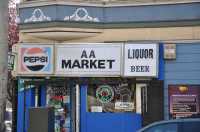
03 Oct More Liquor Stores, More Crime
MedicalResearch.com Interview with:
Pamela Trangenstein, PhD
While a predoctoral fellow at
Johns Hopkins Bloomberg School of Public Health’s Center on Alcohol Marketing and Youth (CAMY)
MedicalResearch.com: What is the background for this study? What are the main findings?
Response: Research repeatedly shows that alcohol outlet density (the number of businesses that sell alcohol in an area) is associated with violent crime, but studies disagree about whether alcohol outlets that are on premise (e.g., bars, restaurants) or off premise (e.g., liquor stores, beer and wine stores) have a stronger association with violent crime.
We used advanced methods that consider both the number of alcohol outlets and their locations to better understand how the association between alcohol outlets and violent crime differs by type of outlet.
We found that alcohol outlets that allow off-premise sales like liquor stores had a stronger association with homicide, aggravated assault, and robbery than on-premise outlets like bars and restaurants. We also found that disadvantaged neighborhoods had higher access to the types of alcohol outlets associated with the most harms: off-premise outlets.
MedicalResearch.com: What should readers take away from your report?
Response: Alcohol outlets are a feature of our built environment and are associated with public health harms, and alcohol outlet density is a health equity issue. Accurate and scientifically valid monitoring of alcohol outlet density and outlet operations should be a routine feature of public health surveillance. When considering how to regulate alcohol outlet licensing and operations, local jurisdictions may want to consider additional measures for alcohol outlets that sell for off-site consumption. Violence reduction programs should consider alcohol outlets, particularly off-premise outlets.
MedicalResearch.com: What recommendations do you have for future research as a result of this work?
Response: Future research should more precisely identify the characteristics of alcohol outlets that are associated with the most harms. For example, researchers may consider violation histories, outlet size, outlet features (e.g., plexiglass barriers), advertising, and product mix (e.g., single-serve containers, flavored beverages).
Disclosures: This research was supported by Award Numbers T32AA007240, Graduate Research Training in Alcohol Problems: Alcohol-related Disparities and P50AA005595, Epidemiology of Alcohol Problems: Alcohol-Related Disparities from the National Institute on Alcohol Abuse and Alcoholism. The content is solely the responsibility of the authors and does not necessarily represent the official view of the National Institute on Alcohol Abuse and Alcoholism or the National Institutes of Health.
Pamela J. Trangenstein, Frank C. Curriero, Daniel Webster, Jacky M. Jennings, Carl Latkin, Raimee Eck, David H. Jernigan. Outlet Type, Access to Alcohol, and Violent Crime. Alcoholism: Clinical and Experimental Research, 2018; DOI: 10.1111/acer.13880
Citation:
Outlet Type, Access to Alcohol, and Violent Crime
Pamela J. Trangenstein Frank C. Curriero
Daniel Webster Jacky M. Jennings Carl Latkin
Raimee Eck David H. Jernigan
- Alcoholism: Clinical and Experimental Research 26 September 2018
[wysija_form id=”3″]
[last-modified]
The information on MedicalResearch.com is provided for educational purposes only, and is in no way intended to diagnose, cure, or treat any medical or other condition. Always seek the advice of your physician or other qualified health and ask your doctor any questions you may have regarding a medical condition. In addition to all other limitations and disclaimers in this agreement, service provider and its third party providers disclaim any liability or loss in connection with the content provided on this website.
Last Updated on October 3, 2018 by Marie Benz MD FAAD

